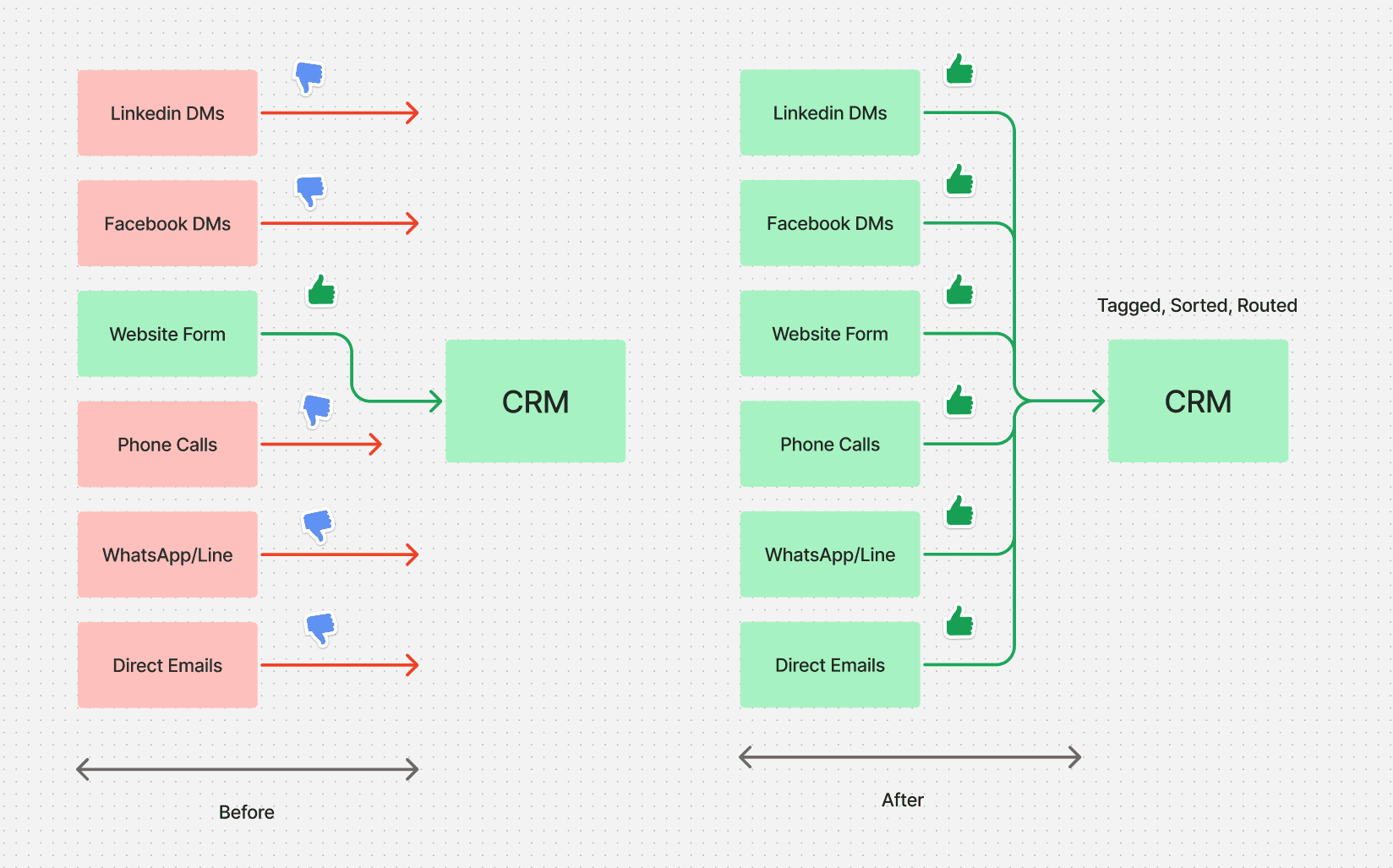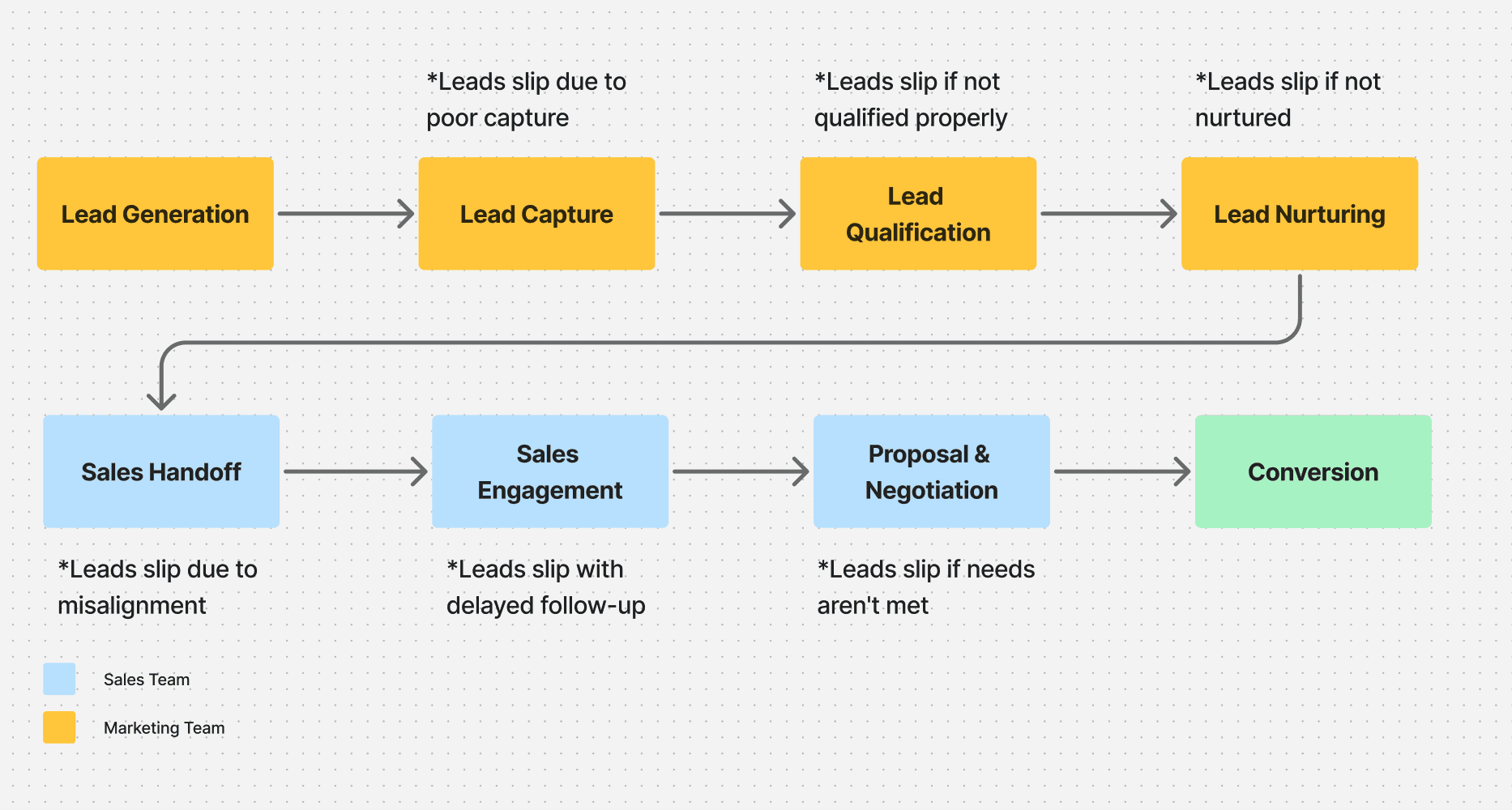Discover why your leads are falling through the cracks and how a unified lead management system can streamline your processes, save time, and boost sales
Saif Abbas
7
min read
You’re putting in the work—running email campaigns, posting on social media, sending LinkedIn messages, and collecting website form inquiries. But somehow, those leads vanish. They’re not converting into sales, and you’re left wondering, “Where did they all go?”
Sound familiar? You’re not alone. Most businesses face this problem, and the culprit is almost always the same: scattered tools, manual processes, and no unified system to hold everything together. The result? Lost revenue, frustrated teams, and wasted effort.
But it doesn’t have to be this way.
The fix? A streamlined lead management system that captures every lead, keeps it organized, and automates the follow-ups. No more missed opportunities. Just a simple, smooth process from prospect to customer.
Let’s break down why this happens—and how you can fix it.
The Real Problem: Your System is Working Against You
In Southeast Asia, your leads aren’t falling through the cracks because you’re not working hard enough. They’re falling because your system doesn’t understand the complexity of this market—think language diversity, the dominance of messaging apps like WhatsApp, and the varied ways people connect.
1. Too Many Tools, Not Enough Results
Picture this: leads coming in from WhatsApp, LINE, email, social media, LinkedIn, and website forms. But instead of landing in one place, they’re scattered across spreadsheets, messaging apps, and sticky notes. In Southeast Asia, where messaging apps often dominate lead communication, this chaos can easily spiral out of control. Marketing and sales teams use different tools, and nothing connects.
Sound chaotic? It is.
To make this even clearer, take a look at the workflow comparison below

“When leads come from everywhere but there’s no single system to catch them all, they just… disappear.”
The solution? Fewer tools, better integration.
2. Manual Processes Slow Everything Down
In Indonesia, for example, many businesses rely heavily on WhatsApp for customer inquiries ( 86.9 million active users). Logging these inquiries, assigning follow-ups, and tracking progress—especially when done manually—leads to frequent mistakes. The high volume of WhatsApp messages can quickly become overwhelming without an automated system in place.
“We found sales reps spending hours a week just trying to update their CRM. That’s time they could’ve spent selling.”
Automating repetitive tasks like follow-ups and lead scoring gives your team time to focus on what matters—closing deals.
3. Disorganized Data Equals Missed Leads
Your CRM stores contact info, but does it actually work for you? In Singapore, many businesses act as regional hubs, managing branches across Southeast Asia. Without a proper system, managing leads across different branches becomes a nightmare. Each country manager handles their own team, and without centralized tagging and scoring, leads fall through the cracks—leaving opportunities scattered across regions and teams.
“Without tagging or sorting, you’re left guessing where leads are in your pipeline. Guesswork isn’t a strategy.”
According to a survey by the Singapore Business Federation (SBF), most businesses in Singapore (67%) say digital tools have helped them work better. However, two main problems are stopping them from doing more: it costs too much money, and they can't find enough trained workers to help.
Centralized systems that tag, score, and route leads automatically can fix this. Every lead gets the attention it deserves—at the right time.
The Cost of Chaos: More Than Just Inefficiency
This isn’t just about inefficiency. It’s about frustration:
Sales reps feel overwhelmed chasing cold leads.
Marketing teams can’t explain poor conversion rates.
Business leaders question if all this effort is worth it.
Chaos costs you time, money, and peace of mind.
The good news? The solution is easier than you think.
What’s Changed: Why Lead Management Feels Harder
Lead management today is more complex than ever. Why?
1. Leads Come from Everywhere
Your leads are on LinkedIn, filling out forms on your site, replying to cold emails, or sending DMs. They’re not following a neat, linear path—they’re all over the place. Without a unified system, these touchpoints feel disconnected, and leads slip away.
2. Longer Sales Cycles (Especially in B2B)
In B2B, deals take weeks—or months. Multiple decision-makers, higher stakes, and endless back-and-forth make the process long and complicated. Managing this without the right system is a recipe for chaos.

3. Why Traditional CRMs Fall Short
CRMs were built for storage, not for sales transformation. They focus on keeping contact details in one place but lack the intelligence to manage multi-touch journeys or enable collaboration.
Limited Automation: Most CRMs require manual follow-ups and lead tracking.
Poor Integration: They don’t sync easily with marketing tools, leaving data scattered.
No Real Insights: They store information but fail to provide actionable insights like lead scoring or tracking engagement.
“A CRM is just a digital filing cabinet. What you need is a system that actually works for you.”
How to Fix It
Leads don’t fall through the cracks because your team isn’t working hard enough. They fall because your system isn’t working smart enough.
1. Automate the Repetitive Stuff
Stop wasting time on manual follow-ups, lead routing, and task assignments. With automation, you can:
Instantly follow up when a lead fills out a form.
Route leads to the right team member based on interest.
Score leads automatically based on their engagement.
Automation doesn’t just save time—it ensures nothing gets missed.
2. Tag and Score Your Leads
Not every lead is ready to buy. That’s okay. By tagging and scoring leads based on behavior, you can prioritize the hottest ones while nurturing the rest.
Tagging: Label leads (e.g., “visited pricing page” or “downloaded whitepaper”) so follow-ups feel personal.
Scoring: Assign points for actions like opening emails or attending webinars. When they’re ready, sales will know.
“Tagging and scoring mean you spend less time guessing and more time closing.”
3. Bring Marketing and Sales Together
When marketing generates leads and sales doesn’t follow up, it’s like pouring water into a bucket with holes. Align both teams by:
Using a shared system where everyone has visibility.
Defining clear handoff points (e.g., when a lead becomes ‘qualified’).
Creating feedback loops to improve lead quality over time.
When marketing and sales work as one, leads stop falling through the cracks.
Real-Life Results: How One Business Turned Chaos into Clarity
Before: A global turf distributor struggled with disjointed tools, manual processes, and poor alignment between marketing and sales. Opportunities were lost, and their pipeline felt unmanageable.
After: We helped them implement a comprehensive system for automation, tagging, and centralized lead capture. We even built their infrastructure before launching any marketing campaigns. The results?
They generated 400+ leads in 10 months (mix of Organic and Paid).
Lead conversion rates jumped to 20–30%.
Sales reps saved hours weekly, focusing more on closing deals.
"Before Incify, collecting leads, tagging, sorting, and routing was all done manually. We lost hours in the process, often resulting in delayed responses—and even a slight delay could mean losing a viable lead. Incify fixed all of that. Now, we’ve freed up our time, and the improvements have significantly boosted our sales and pipeline development." - Marcus Lee, Regional Marketing Manager, Jebsen & Jessen Technology.
The Tools That Make It Happen
Fixing your lead management starts with the right tools:
GoHighLevel (GHL): Affordable and all-in-one, ideal for small to mid-sized businesses. Automate follow-ups, manage pipelines, and scale seamlessly.
HubSpot: Advanced and robust, perfect for growing teams needing deep integrations, multi-touch automation, and detailed analytics.
Each tool has its strengths. If your business needs a cost-effective, all-in-one solution without a hefty setup budget, GoHighLevel (GHL) is a solid choice. GHL is powerful and versatile, but it’s built primarily for agencies, which means the learning curve can be steep and requires extensive customization. That’s why we always tailor it to fit our clients’ specific needs.
HubSpot, on the other hand, is the gold standard for B2B. It offers everything a mid-to-large-sized business needs, especially if you value security, integration (such as Salesforce), and flexibility. It’s perfect for businesses that need a robust, scalable system to grow with them, but it come at a heavy investment, training and adaptation.
Why You Need to Act Now
Your competitors are evolving. The future of lead management is here:
AI-Powered Scoring: Instantly identify your most promising leads.
Omnichannel Automation: Engage leads across email, SMS, and social media.
Data-Driven Decisions: Use insights to refine your strategy and maximize ROI.
Act now to stay ahead.
Take the First Step
Ready to stop losing leads? It starts with a free assessment.
We’ll identify gaps in your process and show you how to fix them—so no lead ever slips through again.
Click below to book your free 15-minute call.
Your next lead is waiting—don’t let it fall through the cracks.
